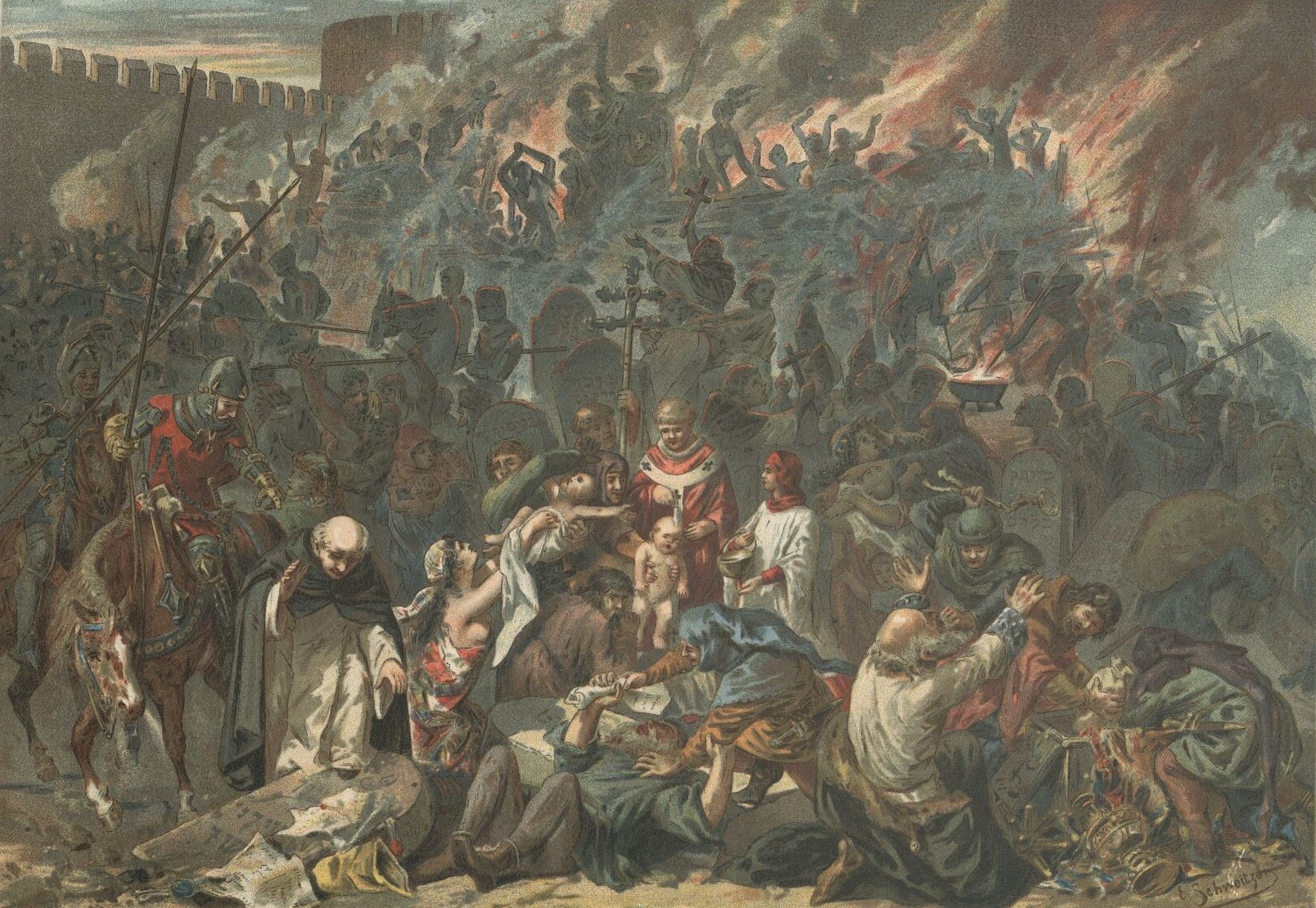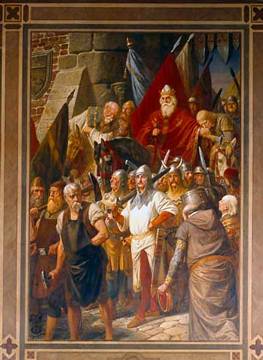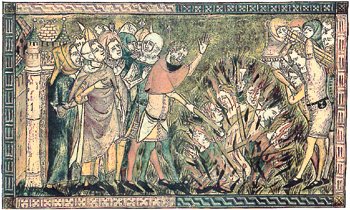|
Strasbourg Pogrom
The Strasbourg massacre occurred on February 14, 1349, when several hundred Jews were publicly burnt to death, and the rest of them expelled from the city as part of the Black Death persecutions. Starting in the spring of 1348, pogroms against Jews had occurred in European cities, starting in Toulon. By November of that year they spread via Savoy to German-speaking territories. In January 1349, burnings of Jews took place in Basel and Freiburg, and on 14 February the Jewish community in Strasbourg was destroyed. This event was heavily linked to a revolt by the guilds five days previously, the consequences of which were the displacement of the master tradesmen, a reduction of the power of the patrician bourgeoisie, who had until then been ruling almost exclusively, and an increase in the power of the groups that were involved in the revolt. The aristocratic families of Zorn and Müllenheim, which had been displaced from the council and their offices in 1332, recovered mos ... [...More Info...] [...Related Items...] OR: [Wikipedia] [Google] [Baidu] |
Pogrom De Strasbourg 1349
A pogrom () is a violent riot incited with the aim of Massacre, massacring or expelling an ethnic or religious group, particularly Jews. The term entered the English language from Russian to describe 19th- and 20th-century Anti-Jewish pogroms in the Russian Empire, attacks on Jews in the Russian Empire (mostly within the Pale of Settlement). Similar attacks against Jews which also occurred at other times and places retrospectively became known as pogroms. Sometimes the word is used to describe publicly sanctioned purgative attacks against non-Jewish groups. The characteristics of a pogrom vary widely, depending on the specific incident, at times leading to, or culminating in, massacres. Significant pogroms in the Russian Empire included the Odessa pogroms, Warsaw pogrom (1881), Kishinev pogrom (1903), Kiev pogrom (1905), and Białystok pogrom (1906). After the collapse of the Russian Empire in 1917, several pogroms occurred amidst the power struggles in Eastern Europe, including t ... [...More Info...] [...Related Items...] OR: [Wikipedia] [Google] [Baidu] |
Blood Libel
Blood libel or ritual murder libel (also blood accusation) is an antisemitic canardTurvey, Brent E. ''Criminal Profiling: An Introduction to Behavioral Evidence Analysis'', Academic Press, 2008, p. 3. "Blood libel: An accusation of ritual murder made against one or more persons, typically of the Jewish faith".Chanes, Jerome A. ''Antisemitism: A Reference Handbook'', ABC-CLIO, 2004, pp. 34–45. "Among the most serious of these nti-Jewishmanifestations, which reverberate to the present day, were those of the libels: the leveling of charges against Jews, particularly the blood libel and the libel of desecrating the host."Goldish, Matt. ''Jewish Questions: Responsa on Sephardic Life in the Early Modern Period'', Princeton University Press, 2008, p. 8. "In the period from the twelfth to the twentieth centuries, Jews were regularly charged with blood libel or ritual murder that Jews kidnapped and murdered non-Jews as part of a Jewish religious ritual." which falsely accuses Jews of ... [...More Info...] [...Related Items...] OR: [Wikipedia] [Google] [Baidu] |
House Of Luxembourg
The House of Luxembourg ( lb, D'Lëtzebuerger Haus; french: Maison de Luxembourg; german: Haus Luxemburg) or Luxembourg dynasty was a royal family of the Holy Roman Empire in the Late Middle Ages, whose members between 1308 and 1437 ruled as kings of Germany and Holy Roman emperors as well as kings of Bohemia, Hungary and Croatia. Their rule was twice interrupted by the rival House of Wittelsbach. History This royal Luxembourg dynasty were not direct descendants of the original counts of Luxembourg, but descended instead from their relatives, a cadet branch of the Lotharingian ducal House of Limburg-Arlon. In 1247 Henry, younger son of Duke Waleran III of Limburg inherited the County of Luxembourg, becoming Count Henry V of Luxembourg, upon the death of his mother Countess Ermesinde. Her father, Count Henry "the blind", was count of Namur, through his father, and Luxembourg, through his mother, who was also named Ermesinde. This elder Ermesinde was a member of the original H ... [...More Info...] [...Related Items...] OR: [Wikipedia] [Google] [Baidu] |
Imperial Immediacy
Imperial immediacy (german: Reichsfreiheit or ') was a privileged constitutional and political status rooted in German feudal law under which the Imperial estates of the Holy Roman Empire such as Imperial cities, prince-bishoprics and secular principalities, and individuals such as the Imperial knights, were declared free from the authority of any local lord and placed under the direct ("immediate", in the sense of "without an intermediary") authority of the Holy Roman Emperor, and later of the institutions of the Empire such as the Diet ('), the Imperial Chamber of Justice and the Aulic Council. The granting of immediacy began in the Early Middle Ages, and for the immediate bishops, abbots, and cities, then the main beneficiaries of that status, immediacy could be exacting and often meant being subjected to the fiscal, military, and hospitality demands of their overlord, the Emperor. However, with the gradual exit of the Emperor from the centre stage from the mid-13th century on ... [...More Info...] [...Related Items...] OR: [Wikipedia] [Google] [Baidu] |
Landfrieden
Under the law of the Holy Roman Empire, a ''Landfrieden'' or ''Landfriede'' (Latin: ''constitutio pacis'', ''pax instituta'' or ''pax jurata'', variously translated as "land peace", or "public peace") was a contractual waiver of the use of legitimate force, by rulers of specified territories, to assert their own legal claims. This especially affected the right of feuding. Scope ''Landfrieden'' agreements formed the political basis for pursuing claims without resorting to the private use of violence. They also often regulated the jurisdiction and thus allowed the settlement of disputes through judgements based on a common set of rules. Offences or violations of the public peace were liable to severe punishment. For example, objects or buildings (such as churches, homes, mills, agricultural implements, bridges, and especially imperial roads) and people (priests, pilgrims, merchants, women, even farmers, hunters and fishermen in carrying out their work) could be placed under prot ... [...More Info...] [...Related Items...] OR: [Wikipedia] [Google] [Baidu] |
Count Of Württemberg
Count (feminine: countess) is a historical title of nobility in certain European countries, varying in relative status, generally of middling rank in the hierarchy of nobility. Pine, L. G. ''Titles: How the King Became His Majesty''. New York: Barnes & Noble, 1992. p. 73. . The etymologically related English term "county" denoted the territories associated with the countship. Definition The word ''count'' came into English from the French ''comte'', itself from Latin ''comes''—in its accusative ''comitem''—meaning “companion”, and later “companion of the emperor, delegate of the emperor”. The adjective form of the word is "comital". The British and Irish equivalent is an earl (whose wife is a "countess", for lack of an English term). In the late Roman Empire, the Latin title ''comes'' denoted the high rank of various courtiers and provincial officials, either military or administrative: before Anthemius became emperor in the West in 467, he was a military ''comes ... [...More Info...] [...Related Items...] OR: [Wikipedia] [Google] [Baidu] |
Margrave Of Baden
The Margraviate of Baden (german: Markgrafschaft Baden) was a historical territory of the Holy Roman Empire. Spread along the east side of the Upper Rhine River in southwestern Germany, it was named a margraviate in 1112 and existed until 1535, when it was split into the two margraviates of Baden-Durlach and Baden-Baden. The two parts were reunited in 1771 under Margrave Charles Frederick, even if the three parts of the State maintained their distinct seats to the Reichstag.Votes number 58 Baden, 60 Durlach, 62 Höchberg. The restored Margraviate of Baden was elevated to the status of electorate in 1803. In 1806, the Electorate of Baden, receiving territorial additions, became the Grand Duchy of Baden. The rulers of Baden, known as the House of Baden, were a cadet line of the Swabian House of Zähringen. History During the 11th century, the Duchy of Swabia lacked a powerful central authority and was under the control of various comital dynasties, the strongest of them being t ... [...More Info...] [...Related Items...] OR: [Wikipedia] [Google] [Baidu] |
Bishop Of Strasbourg
{{Unreferenced, date=December 2009 These persons were bishop, archbishop or prince-bishop of the Roman Catholic Archdiocese of Strasbourg (including historically Prince-Bishopric of Strasbourg): Bishops and prince-bishops *Amandus *Justinus von Straßburg *Maximinus von Straßburg *Valentinus *Solarius * Arbogast *Florentius *Ansoaldus *Biulfus *Magnus von Straßburg *Aldo *Garoinus *Landbertus *Rotharius *Rodobaldus *Magnebertus *Lobiolus *Gundoaldus *Udo I ( ~ 700) *Witgern (728 - ?) *Wandalfried ( - 735?) * Heddo (739 – 765) *Ailidulf (765?) *Remigius von Straßburg (765 - March 20, 783) *Ratho (783 – 815) *Udo II (815) *Erlehard (815? - 822?) * Adeloch (817 - April 17, 840) *Bernald (840 - November 21, 875) *Udo III (840) *Rathold (875 - May 10, 888) *Reginhard (876 – 888) *Walram (888 – 906) *Otbert (906 - August 30, 913) *Gozfrid (September 13, 913 - November 6, 913) * Richwin (914 - August 30, 933) *Ruthard (933 - April 15, 950) *Udo IV (950 - August 26, 965) (Kon ... [...More Info...] [...Related Items...] OR: [Wikipedia] [Google] [Baidu] |
Cologne
Cologne ( ; german: Köln ; ksh, Kölle ) is the largest city of the German western States of Germany, state of North Rhine-Westphalia (NRW) and the List of cities in Germany by population, fourth-most populous city of Germany with 1.1 million inhabitants in the city proper and 3.6 million people in the Cologne Bonn Region, urban region. Centered on the left bank of the Rhine, left (west) bank of the Rhine, Cologne is about southeast of NRW's state capital Düsseldorf and northwest of Bonn, the former capital of West Germany. The city's medieval Catholic Cologne Cathedral (), the third-tallest church and tallest cathedral in the world, constructed to house the Shrine of the Three Kings, is a globally recognized landmark and one of the most visited sights and pilgrimage destinations in Europe. The cityscape is further shaped by the Twelve Romanesque churches of Cologne, and Cologne is famous for Eau de Cologne, that has been produced in the city since 1709, and "col ... [...More Info...] [...Related Items...] OR: [Wikipedia] [Google] [Baidu] |
Breaking Wheel
The breaking wheel or execution wheel, also known as the Wheel of Catherine or simply the Wheel, was a torture method used for public execution primarily in Europe from antiquity through the Middle Ages into the early modern period by breaking the bones of a criminal or bludgeoning them to death. The practice was abolished in Bavaria in 1813 and in the Electorate of Hesse in 1836: the last known execution by the "Wheel" took place in Prussia in 1841. In the Holy Roman Empire it was a "mirror punishment" for highwaymen and street thieves, and was set out in the ''Sachsenspiegel'' for murder, and arson that resulted in fatalities. Punishment Those convicted as murderers, rapists, traitors and/or robbers to be executed by the wheel, sometimes termed to be "wheeled" or "broken on the wheel", would be taken to a public stage scaffold site and tied to the floor. The execution wheel was typically a large wooden spoked wheel, the same as was used on wooden transport carts and c ... [...More Info...] [...Related Items...] OR: [Wikipedia] [Google] [Baidu] |
Pope Clement VI
Pope Clement VI ( la, Clemens VI; 1291 – 6 December 1352), born Pierre Roger, was head of the Catholic Church from 7 May 1342 to his death in December 1352. He was the fourth Avignon pope. Clement reigned during the first visitation of the Black Death (1348–1350), during which he granted remission of sins to all who died of the plague. Roger steadfastly resisted temporal encroachments on the Church's ecclesiastical jurisdiction and, as Clement VI, entrenched French dominance of the Church and opened its coffers to enhance the regal splendour of the Papacy. He recruited composers and music theorists for his court, including figures associated with the then-innovative Ars Nova style of France and the Low Countries. Early life Birth and family Pierre Roger (also spelled Rogier and Rosiers) was born in the château of Maumont, today part of the commune of Rosiers-d'Égletons, Corrèze, in Limousin, France, the son of the lord of Maumont-Rosiers-d'Égletons. He had an elder ... [...More Info...] [...Related Items...] OR: [Wikipedia] [Google] [Baidu] |
Well Poisoning
Well poisoning is the act of malicious manipulation of potable water resources in order to cause illness or death, or to deny an opponent access to fresh water resources. Well poisoning has been historically documented as a strategy during wartime since antiquity, and was used both offensively (as a terror tactic to disrupt and depopulate a target area) and defensively (as a scorched earth tactic to deny an invading army sources of clean water). Rotting corpses (both animal and human) thrown down wells were the most common implementation; in one of the earliest examples of biological warfare, corpses known to have died from common transmissible diseases of the Pre-Modern era such as bubonic plague or tuberculosis were especially favored for well-poisoning. Additionally, well poisoning was one of the three gravest antisemitic accusations made against Jews during the pre-modern period (the other two being host desecration and blood libel). Similar accusations were also made o ... [...More Info...] [...Related Items...] OR: [Wikipedia] [Google] [Baidu] |









